Smoked Brisket On a Schedule
Smoked brisket and burnt ends are a special treat these days in the Carr household. This past weekend was the second time I’ve made brisket on the smoker, and it’s a significant time commitment, but the payoff is worth it. I wrote a few weeks ago about how my butcher has hiked their price for brisket from $3.99 to $5.99, which is a significant jump in cost for smoked brisket. Thanks to a neighbor, I was able to get an 18-pound packer (both point and flat cuts) for $3.69 per pound at Costco. Despite my wife raising the alarm when I brought it home, I didn’t quite consider how damn big this chunk of meat was, and as it turned out, had trouble fitting it on my 18.5″ Weber Smokey Mountain cooker. There are worse problems one could have, I suppose, when making smoked brisket.
Food: Brisket and Burnt Ends
Temperature: 250-275°
Cooking time: 9-12 hours
Wood used: Cherry
Notes: Trimmed to 1/4″ fat cap, slathered lightly with yellow mustard and then rubbed with salt/pepper (1:1) and Billy Bub’s Dry Rub, cooked low and slow until internal temperature reaches 202-205°
The Smoked Brisket Plan
I got up at 6:00 AM to trim the brisket and start the smoker. With guests coming for dinner and the uncertainty in cooking a piece of meat this big, I gave some real thought to getting up at 4:00 or 5:00 instead, but decided to chance it and hope that I didn’t run into any weird stalls or delays. It was 32F outside when I started the smoker, with 83% humidity and 1 mph NE wind. Other than the cold, these seemed like good conditions for smoking a brisket.
My goal was to keep the temperature between 250 and 275, then pull both cuts after four hours. I would wrap the flat in butcher paper and throw it back on the smoker until it hits 202, then let it rest for an hour. For the point, I would put it in a half sheet (18″ x 13″) baking pan with beef broth to let it render and come up to 205, then cube the point into burnt ends, separate the fat off from the broth and put it back in the pan with some sauce to glaze over the tops of the burnt ends and set. This usually takes about 20 minutes, but I had company coming at 4:00 PM and wanted to save the burnt ends until closer to their arrival, so I planned to wrap it in foil to keep the temp up, then put it back on the smoker for longer (maybe 45 minutes) in the sauce/broth mixture.
For this cook, and like last time, I followed Malcolm Reed‘s recommendation for cooking smoked brisket burnt ends. If you haven’t seen Malcom’s site, HowToBBQRight.com, you’re missing out on a great resource. His videos were very influential in making me want to buy a smoker and start making some of the stuff from his site.
Trimming the Brisket
I went a little aggressively on the trimming last time, and spent the evening wondering if perhaps I had trimmed off too much. This time I decided to leave 1/4″ of fat on the bottom of the flat, which is twice what I aimed for last time (though I think I trimmed more off than I had planned) and would help ensure a little less of the brisket dryness. In retrospect, I actually left a little more than this on the flat, probably close to 3/4″ on one corner, and almost certainly because I couldn’t quite tell the thickness in that area during trimming.
The trimming went faster than it did last time and I was pleased that this brisket wasn’t as fatty as the last one. I wasted about 1/3 of the weight last time on trimmed fat, whereas this was probably closer to 15%. It cleaned up nicely and I was able to finish trimming and get the slather and rub applied within about 30 minutes. I spent 45 minutes on these steps last time.
I cooked using the minion method again, which has worked very well for me in previous cooks. The smoker was up and running within about 15-20 minutes after starting the chimney of charcoal, and I was off to the races.
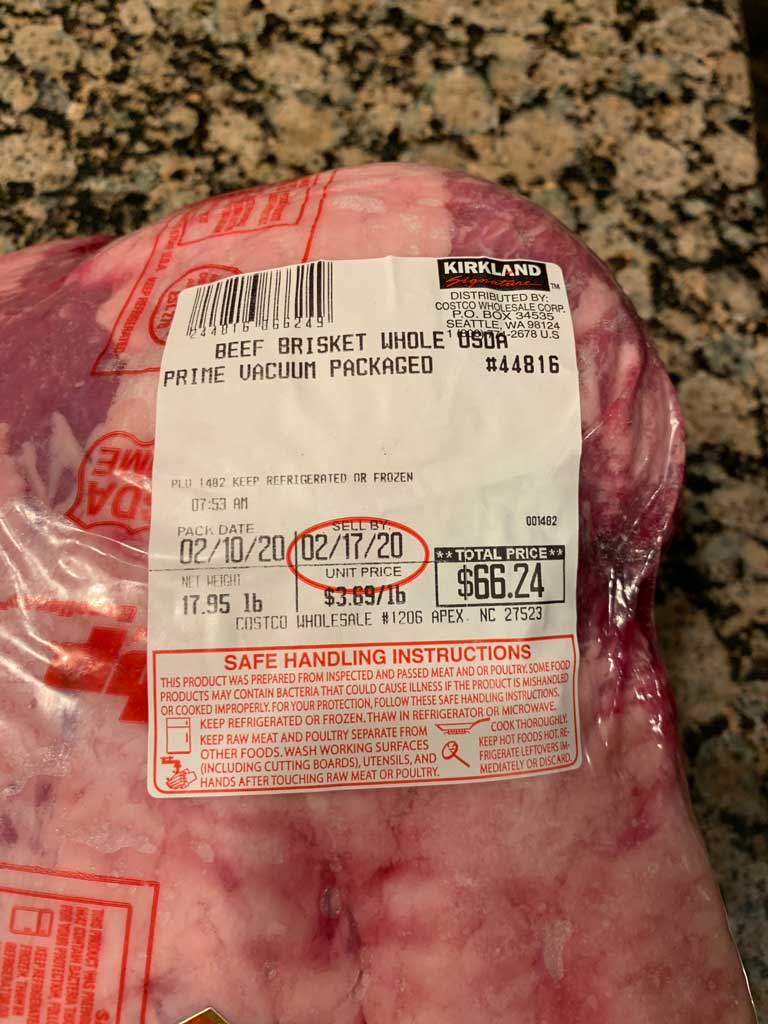
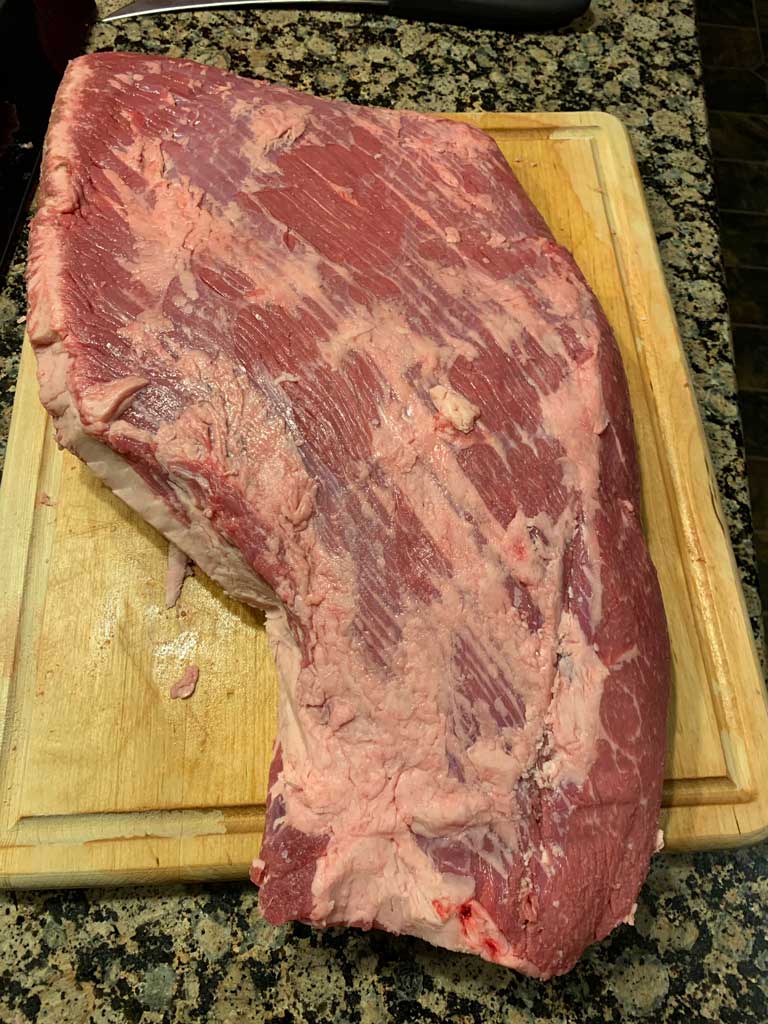
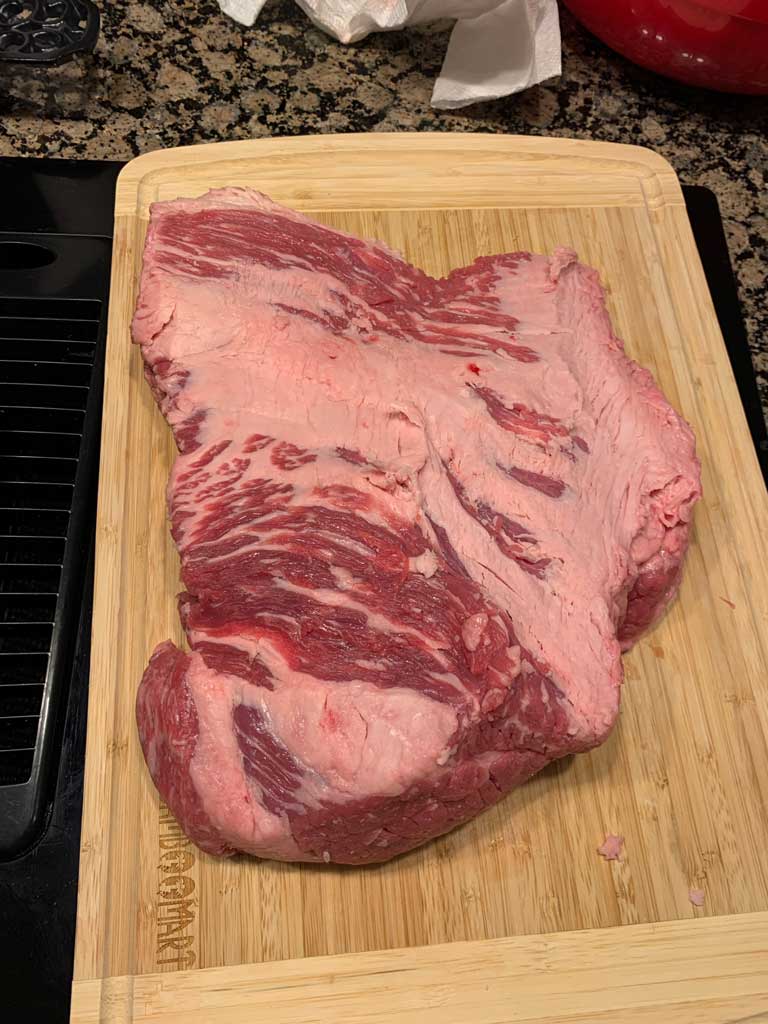
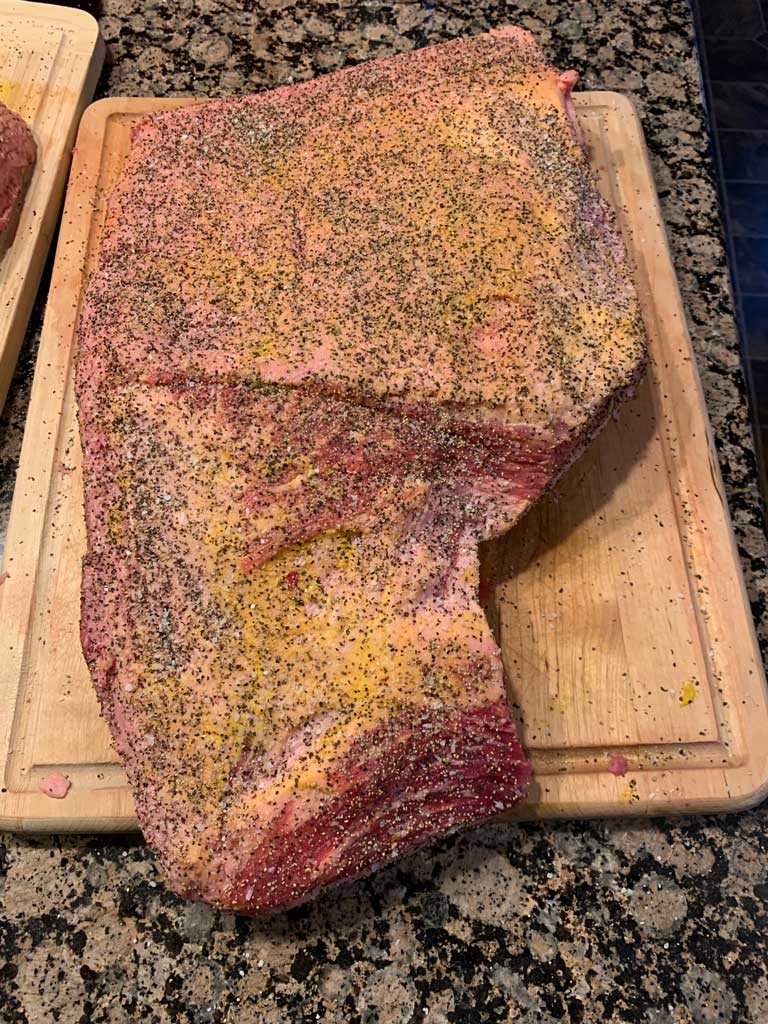

Cooking the Point
Trying to hold off finishing the point until closer to when our guests arrive made me really nervous. I had pulled the point after four hours and placed in a pan that I filled with beef broth. This allows the point to continue soaking up juices while the fats render from that amazing marbling it had. I used this same approach last time and it worked great. Normally, I would pull it when it hits 202-205 degrees, slice it into 1×1″ cubes, and mix some sauce in with the broth after separating the rendered fat. Then I’d drizzle some more sauce over the tops of the burnt ends, using a silicon brush to glaze them, and then throw them back on the smoker for 15-20 minutes to let the glaze set. Instead, I decided to wrap the pan real good with tinfoil once they hit their temperate, then leave it sitting for an hour and a half or so. I’d slice them, and put them back on the smoker closer to when my in-laws were expected, with the understanding they would need a little longer not only for the sauce glaze to set, but for their temperature to come back up.
This worked better than I thought. When I felt them during slicing, I was worried they had toughened up from sitting. This wasn’t the case at all, and they were fantastic, even with the break in cooking. This is definitely good to know for the future since the point finishes so much faster than the flat.


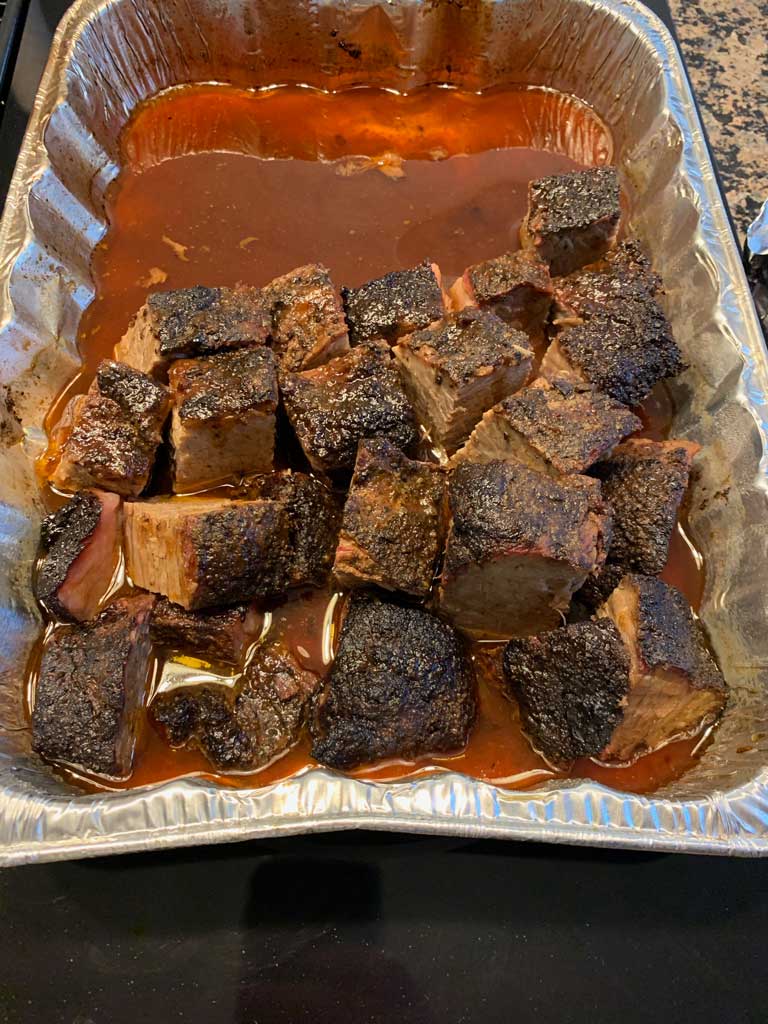
Cooking the Flat
I had significant problems controlling the temperature of the smoker after removing the point. Smoked brisket takes a long time, which gives plenty of opportunity for things to happen. I think this was a combination of a few things. Putting the meats back on the smoker after hours hours (the flat wrapped, the point in a pan of broth) caused a huge drop in the temperature, as would be expected. Getting the temperature back up was a struggle, and I think the lack of any wind was a factor. There just wasn’t enough air getting into the vents to bring the charcoal up sufficiently. I ended up taking the door off the smoker at one point, which helped. Unfortunately, the temperature came up about the time I took the point off, leaving only half the amount of meat to absorb heat and causing a crazy spike in temperature, hitting 390 degrees at one point. After a little quick research, I learned that this is not an uncommon occurrence. I basically had to shut the vents entirely to get the temperatures down, but then struggled to get them back up when they went too low. The whole ordeal was frustrating and stabilizing the cooker temperature was much harder during this cook than in previous ones.
I don’t know what impact this had on the flat. Once the temperatures came back up and appeared to be somewhat stable, I kept them a tad high to make up for lost time, especially since I only gave myself about 90 minutes of buffer between when I expected to come off and when we were planning to eat. This worked fine and the internal temperature on the flat continued to rise, appearing to stall around 198. I went out and reset the temperature probe and noticed that it read 202, so I went ahead and pulled the flat to rest.
I let the flat rest on a counter wrapped in butcher paper. In the past, I’ve put it into a cooler, but that was because I needed to keep it hot longer. I still think that’s the right approach, even if only resting for an hour or so. I don’t know that there was a measurable downside to using just the butcher paper, but it would have stayed even hotter in the cooler.
Observations
It came out good, perhaps better than last time. Even smoked brisket that isn’t dry when you cut it seems to be noticeably dryer once it cools for a couple minutes on your plate. I’ve become convinced this is just a characteristic of brisket, and I’ve become more of a proponent of using a drizzle of sauce on it. The burnt ends made a nice appetizer and despite my in-laws not being particularly fans of smoked meats, they both enjoyed the burnt ends. By contrast, I could eat them three times per day, every day.
I’m still in awe at how much meat results from an 18-pound brisket. After dinner with my in-laws and a second dinner with just the four of us, we’ve barely made it through half the brisket and two-thirds of the burnt ends are left. I may have to explore using some of the leftovers for tacos or something to help us get through it all; it would be a shame to waste any of it.
Cooking Log
| Time | Grill Temp | Flat Temp | Point Temp | Vents | Comments |
| 7:15 AM | 210° | 42 | 46 | 100% | Both cuts of meat on |
| 7:30 AM | 212° | 44 | 50 | ||
| 8:00 AM | 276 | 68 | 98 | 25% | |
| 8:30 AM | 260 | 105 | 135 | 34 outside | |
| 9:00 AM | 251 | 124 | 149 | 30% | Opened vents slightly |
| 9:30 AM | 257 | 137 | 157 | 37 outside | |
| 10:00 AM | 257 | 146 | 160 | 43 outside | |
| 10:30 AM | 307 | 152 | 162 | 15% | Closed vents to lower heat |
| 11:00 AM | 247 | 158 | 164 | 46 outside | |
| 11:15 AM | 261 | 158 | 163 | Stirred coals, opened vents | |
| 11:30 AM | 138 | 157 | 150 | 25% | Flat wrapped, put point in pan with broth |
| 11:45 AM | 202 | 156 | 152 | 75% | Added charcoal, opened vents |
| 12:00 PM | 221 | 156 | 162 | ||
| 12:30 PM | 228 | 160 | 179 | 100% | Struggling to get temp back up |
| 1:00 PM | 253 | 167 | 194 | Took door off to increase temp | |
| 1:05 PM | 284 | 167 | 194 | 53 outside | |
| 1:30 PM | 243 | 173 | 204 | Temp stabilizing, removed point | |
| 1:45 PM | 377 | Removing point caused spike | |||
| 2:00 PM | 355 | 180 | 10% | Closed off vents to lower temp | |
| 2:15 PM | 265 | 182 | 50% | Back in range, 55 outside | |
| 2:30 PM | 275 | 185 | 60% | ||
| 3:00 PM | 280 | 188 | |||
| 3:30 PM | 255 | 190 | |||
| 3:45 PM | Put burnt ends back on to glaze | ||||
| 4:00 PM | 305 | 194 | 50% | Added charcoal, stirred coals | |
| 4:30 PM | 312 | 197 | |||
| 4:50 PM | 320 | 202 | Flat removed to rest |
I’m already looking forward to the next smoked brisket, but probably won’t do it again until in the spring. It’s just such a time commitment. Man, it sure is good though! Ultimately, I’d like to mix the next cook with a get-together so that I can hang out with friends a little, enjoy a couple of beers, and spend less time looking out at the smoker from the warm confines of the house.
Additional Resources
- HowToBBQRight: How to Make Burnt Ends
- Billy Bub’s BBQ Rub, purchased at Harris Teeter











